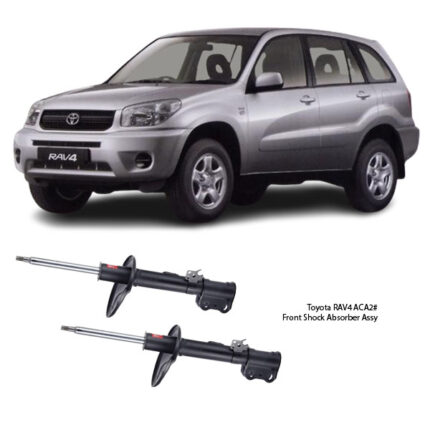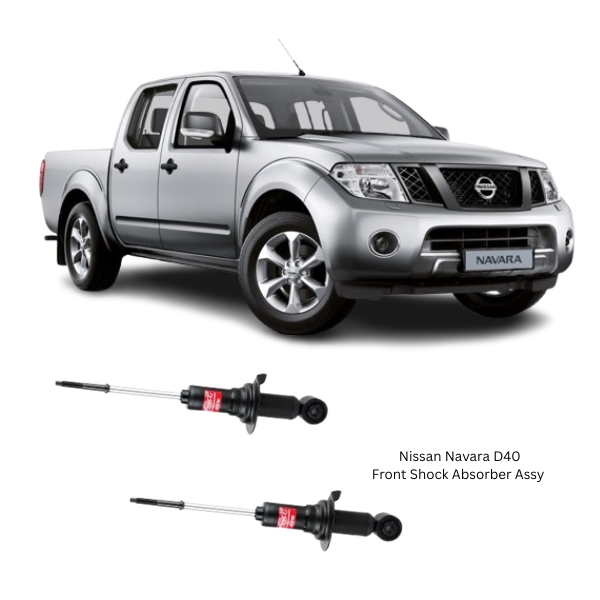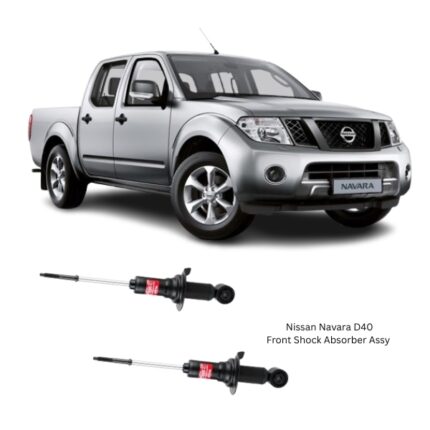Get Nissan Navara D40 Front Shock Absorber Assy 340053 in Kenya
The Front Shock Absorber Assembly is a crucial component of a vehicle’s suspension system, engineered to manage the dynamics of wheel movement, absorb road impacts, and maintain tire contact with the surface. Its design ensures improved vehicle stability, ride comfort, and control, especially when navigating uneven or unpredictable terrains.
Function and Purpose
The primary function of the front shock absorber assembly is to dampen the oscillations that occur when a vehicle drives over bumps or dips. While springs handle vertical forces, the shock absorber controls the energy released by the spring’s movement. Without proper shock absorption, the vehicle would bounce excessively, reducing traction and making steering unpredictable.
The front position of this component plays a more active role in controlling weight transfer during braking and cornering. It ensures that front wheels maintain optimal ground contact, enabling precise handling and braking responsiveness. The assembly is especially vital during sudden stops or sharp turns, where it helps distribute forces evenly to prevent instability or nose diving.
Construction and Design
A typical front shock absorber assembly consists of a cylinder (or tube) filled with hydraulic fluid, a piston rod, and valving systems that control fluid movement. In modern designs, gas-charged technology is often integrated to prevent aeration and cavitation within the fluid, offering consistent damping performance even under strenuous conditions.
Most assemblies are housed within robust steel or aluminum tubes to withstand constant pressure, impact forces, and environmental conditions like dirt, water, and heat. A double-tube or mono-tube configuration may be used, depending on the vehicle’s performance requirements.
Key components of the assembly include:
-
Piston and rod – Converts motion into heat by moving through the fluid inside the cylinder.
-
Base valve and piston valve – Regulate the flow of oil between the chambers.
-
Dust boot or cover – Protects the rod from debris and contaminants.
-
Upper and lower mounting brackets or bushings – Facilitate secure connection to the chassis and control arms.
Material Quality
High-quality materials are critical for long-term performance. The piston rod is often chrome-plated for corrosion resistance and reduced friction, while seals are constructed with heat- and oil-resistant materials to prevent leaks. Internal valves are calibrated with precision to offer the right balance of compression and rebound characteristics.
The housing typically features corrosion-resistant coatings and may be powder-coated or treated with specialized paint to extend the lifespan in harsh conditions. Seals are designed to resist expansion and degradation due to high temperatures or fluid contact, and bushings are made of durable rubber or polyurethane to reduce noise and absorb vibrations.
Performance Characteristics
-
Damping Force: The shock absorber is finely tuned to offer optimal damping forces for both compression (when the suspension is compressed) and rebound (when it extends). This ensures balanced handling and minimizes excessive vehicle roll or pitch.
-
Ride Comfort: It smoothens out bumps and road imperfections, ensuring occupants experience a quieter and more comfortable ride.
-
Handling & Stability: By limiting excessive suspension movement, the front shock absorber helps maintain directional stability, reduces understeer or oversteer, and enhances cornering control.
-
Load Management: When carrying extra weight or during rapid deceleration, the assembly plays a key role in distributing the load evenly across the suspension geometry.
Installation Considerations
Proper installation of a front shock absorber assembly requires attention to mounting torque specifications, alignment, and compatibility with existing suspension components. When replacing a worn unit, it’s often recommended to inspect related parts like control arm bushings, stabilizer links, and strut mounts, as these components work together to ensure effective suspension operation.
It’s common practice to replace shock absorbers in pairs (left and right) to ensure symmetrical performance. Uneven damping can lead to inconsistent handling and premature tire wear.
Symptoms of a Worn Shock Absorber
Over time, shock absorbers can degrade due to wear and tear, fluid leaks, or mechanical damage. Common signs that the front shock absorber assembly may require replacement include:
-
Increased stopping distance
-
Nose-diving while braking
-
Bouncy or uncomfortable ride
-
Excessive body roll in corners
-
Uneven tire wear
-
Visible oil leaks around the shock body
-
Clunking or knocking noises on rough roads
Addressing these symptoms promptly prevents further damage to suspension components and ensures continued driving safety.
Maintenance Tips
Though shock absorbers are generally maintenance-free, routine inspection during regular vehicle servicing is recommended. This includes checking for:
-
Physical damage to the housing or shaft
-
Signs of fluid leakage
-
Loosened or corroded mounting points
-
Worn or deteriorated bushings
Keeping the undercarriage clean from mud, road salt, or corrosive substances helps prolong the life of the shock absorber. Additionally, avoid overloading the vehicle, as excess weight increases strain on the suspension.
Benefits of a Quality Shock Absorber
-
Enhanced Safety: Maintains optimal contact between the tires and road, especially during braking.
-
Comfortable Ride: Smooths out vibrations and jolts from uneven road surfaces.
-
Improved Steering Response: Reduces the delay between steering input and wheel movement.
-
Reduced Wear on Tires and Suspension: Proper damping prevents premature wear on associated components.
-
Long-Term Durability: Designed to withstand extreme road and weather conditions for prolonged service life.




